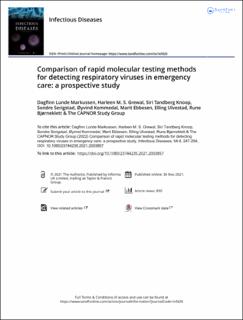| dc.contributor.author | Markussen, Dagfinn Lunde | |
| dc.contributor.author | Grewal, Harleen | |
| dc.contributor.author | Knoop, Siri Tandberg | |
| dc.contributor.author | Serigstad, Sondre | |
| dc.contributor.author | Kommedal, Øyvind | |
| dc.contributor.author | Ebbesen, Marit Helen | |
| dc.contributor.author | Ulvestad, Elling | |
| dc.contributor.author | Bjørneklett, Rune Oskar | |
| dc.date.accessioned | 2022-06-08T08:26:29Z | |
| dc.date.available | 2022-06-08T08:26:29Z | |
| dc.date.created | 2022-05-20T09:43:37Z | |
| dc.date.issued | 2022 | |
| dc.identifier.issn | 2374-4235 | |
| dc.identifier.uri | https://hdl.handle.net/11250/2997825 | |
| dc.description.abstract | Background
Respiratory tract infections (RTIs) caused by contagious viruses are common among patients presenting to the emergency department (ED). Early detection of these viruses can help prevent nosocomial transmission.
Aim
To investigate the efficacy of three rapid molecular methods, namely FilmArray® Pneumonia Panel plus (FAP plus), ID NOW™ Influenza A and B 2 (ID NOW2) point-of-care test, and an in-house real-time polymerase chain reaction (RT-PCR) test, to identify patients with viral RTIs requiring isolation in an emergency setting.
Methods
We included a FilmArray® Pneumonia Panel plus in the initial workup of patients with suspected RTIs during a flu season. The RT-PCR and the influenza point-of-care test were performed as part of routine diagnostics, on demand from the treating physicians. We compared viral detections and compared time to positive test results for each method.
Findings
The FAP plus significantly reduced the turnaround time and was able to identify 95% patients with potential contagious viral RTI. Routine diagnostics ordered by the treating physician had a turnaround time of a median 22 h and detected 87% of patients with potential contagious viral RTI. In patients that had all three tests, the ID NOW2 detected 62% of patients with influenza.
Conclusions
The FAP plus was able to rapidly and reliably identify patients with potential contagious viral RTIs; its use was feasible in the ED setting. Failing to test patients with viral RTI and using tests with long turnaround time may lead to nosocomial transmission of viral infections and adverse patient outcomes. | en_US |
| dc.language.iso | eng | en_US |
| dc.publisher | Taylor & Francis | en_US |
| dc.rights | Attribution-NonCommercial-NoDerivatives 4.0 Internasjonal | * |
| dc.rights.uri | http://creativecommons.org/licenses/by-nc-nd/4.0/deed.no | * |
| dc.title | Comparison of rapid molecular testing methods for detecting respiratory viruses in emergency care: a prospective study | en_US |
| dc.type | Journal article | en_US |
| dc.type | Peer reviewed | en_US |
| dc.description.version | publishedVersion | en_US |
| dc.rights.holder | Copyright 2021 The Author(s) | en_US |
| cristin.ispublished | true | |
| cristin.fulltext | original | |
| cristin.qualitycode | 1 | |
| dc.identifier.doi | 10.1080/23744235.2021.2003857 | |
| dc.identifier.cristin | 2025872 | |
| dc.source.journal | Infectious Diseases | en_US |
| dc.source.pagenumber | 247-254 | en_US |
| dc.identifier.citation | Infectious Diseases. 2022, 54 (4), 247-254. | en_US |
| dc.source.volume | 54 | en_US |
| dc.source.issue | 4 | en_US |

